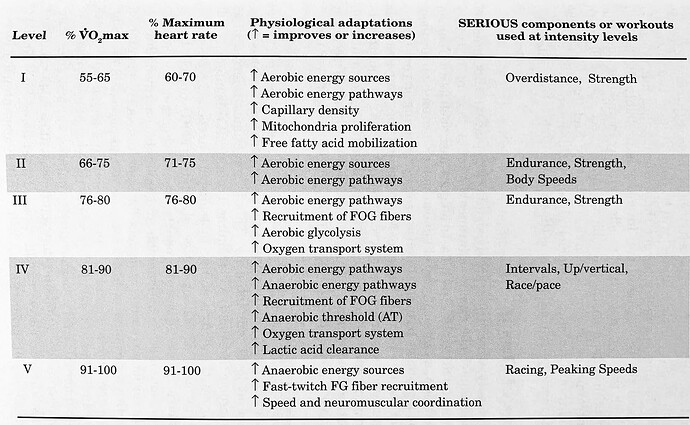Hi guys, I’m new to the platform. I’ve been trying to get a polarized training spread just by using the HR zones Strava has given me. My zone 2 on Strava has been 118 to 156 based on MHR. Since then I have been using Intervals and came across the Friel HR zone model. According to my threshold HR and the Friel model, my zone 2 is now 149-162, which is higher than I am used to calling zone 2. Can anyone explain what I should be using or suggest a better method? My stats are 20yo M, MHR ~210 (I think), threshold HR 184. Thanks for the help!
Try this spreadsheet. It uses maxHR and restingHR then various suggested ranges. Personally, Sleamaker & Browning most accurately represents my physiology.
Check out these videos as well.
Ride on feel, and track your HR as your breathing changes. At the point where breathing feels like an laboured effort is being made, you’re close to your upper limit of zone 2. The more your do this, the better you get at feeling it.
If you want an actual accurate zone definition, your top of Z2 will be the point at the first blood lactate rise. So you need to do the majority of your training below the first blood lactate rise.
No preset zone model is going to tell you what this point is.
In the absence of a test to determine this point, as @Gerald says, you’re best to ride on feel.
Those are some nice links! Thank you.
Do you happen to have some references for the model definitions in the spreadsheet?
I can construct the models based on the formulas but would be interested in seeing the “official” references.
I made something similar to that matrix some time ago but it mostly has the preset models I found through Intervals. The goal was to highlight how “talking about Z2” is somewhat meaningless without the context of the model being used.
I haven’t scoured much of the sports physiology literature to find other alternatives and those on the spreadsheet seem very interesting.
Karvonen: just do an internet search.
Seiler: start here, then go here and here.
Sleamaker & Browning, Serious Training
Yup. That’s why Dr. Iñigo San Milan is pushing for some consensus in definitions and verbiage.
There are others. The ones in the simple matrix are, IMHO, good summaries with the best overall reflection.
If you are trying to do polarized training you can start by planning your hard efforts (like twice a week) and your z2 rides are just of length and intensity to let you perform that hard efforts at max quality. Most science shows there is little advantage between high and low z2 but the difference in fatigue can be much bigger and can result in leaving you with not enough energy for those hard days. Assuming you are training 5-6x times a week (edited ;D) and hard efforts are implemented only for a half of the season (periodisation), it gives you like 30-50 hard efforts and 150-250 easy efforts a year. If you do those z2 rides 20w lower it will still be very productive, but if you miss some hard efforts bc you are too fatigued it is much bigger problem.
All I’m trying to say, it will be very hard to get exact hr numbers and still even if you labtest yourself, your hr is really changing in time, overall fatigue, coffee, no coffee, time from last meal etc. Trying to ride by feel or at least tracking your feel is important. For now I think much more important is focusing on making those rides as steady as possible. If you ride at steady power, you will likely very quickly discover where your z2 ends and tempo starts (just try to do a 3-4h effort at your z2)
That might be a bit too much ![]()
Curious as to what the numbers in the parentheses mean in Seiler’s %HRmax column in your spreadsheet that you linked? Trying to correlate with the TrainerRoad resource by Chad McNeese that I use.
Thanks!
They just represent drawing the Z1/Z2 of 3 (or Z2/Z3 of 5) boundary at 78% of maxHR rather than 82%. 78 is what I find is more representative for the majority of people whereas 82% is more for elite. Seiler also notes this in a few podcasts.
So, I’m planning to do some (a lot in fact) fat bike rides as easy/z2 rides as base. I can’t put 10/12 hrs a week steering to a computer screen.
Would guys think that it’s a good approach?
Whatever works for you, keeps you motivated, and getting the done, is what counts.
that sounds ideal
Just remember Z2 is a huge zone. Lots of scope to vary your workouts within the zone. I’d avoid always riding to the same intensity within Z2. So as a general rule of thumb, the longer your intended workout, the lower down the zone you ride at!
Sure,
My doubts resides more in the fact that fatbiking will be more like trail, not necessarily a steady state z2 intervals. There will be lots of variations. Probably well above z2 while climbing, and below while descending. I guess what matters the most is that after a 2 hr ride I’m happier than 2 hr indoor, and capable of repeating this effort in a sustained way.
If you hold back a bit on the climbs, you will have best of both worlds. Happier and still a decent Z2 time.
Most important is to get the work done, so being happier is high on the priority list.
Hi, is it more efficient to train in z1 or z2? I mean z1/z2 dividing the cake in more than three zones
Currently I am at 115bpm and I am liking it. I come though after a month of real overtrainng though, my HRV still has to get stsble back to baseline
IMO, for the Z1/Z2 (in the not 3 zone models) the important piece is duration/load. There’s a reasonable case that more time in Z1 is comparable to less time in Z2. So if your target for an endurance ride is 100 TSS, which zone probably isn’t hugely important as long as you hit that goal.
This raises interesting questions for what exactly a recovery ride is, if there’s not much difference.
Personally, I think trying to fine tune your “Z2” isn’t that important. Go at a pace you can breath through your nose and your heart rate stays fairly stable. Hit your load target. Err on the easier side, but if you have a time constraint, you can go a little harder. If you’re doing more than 1.5-2 hours, make sure you’re fueling at least 30g an hour.
Curious about swtiching carbs to fst now to see how many grams would that be

